The Week Without Walls (WWW) is a program aiming to provide students with education outside of school. There are several locations scattered throughout the island that are visited by separate groups, each with a different focus. January is always the month of WWW, and I have been looking forward to this field trip for a few months. Last year I went to Jaffna, in the north of Sri Lanka. It was a great trip with many highlights, including fascinating culture, interesting history and some natural highlights too, including thousands of migrant ducks. This year I wanted to try something new, and got into the Highlands group, in which we visited the Sri Lankan highlands from the 21st to 25th January. The focus of this trip was activity, creativity and science, as we climbed Sri Lanka’s three highest peaks while we aimed at finding a variety of animals and recording them using photographing and drawing.
Here is a link to the map of our trip, including hiking trails.
On Monday, we departed school at 7 AM, and after a fun but long bus ride we arrived at Belihuloya for lunch at around 12 PM. Before lunch we went down to the stream, trying out some long exposure photography of water. We then hiked to the campsite, which was about a 4-hour hike, including a swim in the nearby stream. After dinner, we went on a nocturnal walk, but we did not see anything special. The hike was in the sun most of the time, but it was interesting to see rice fields up close, and we could compare the different stages of the growth and how much water is kept in the fields.
Early on Tuesday morning, Mr Lockwood and I tried to find Indian Pitta, a beautiful bird I have only seen twice before, but all we got was one calling very close to us. Equally exciting were distantly calling Sri Lanka Spurfowl, a very difficult-to-see endemic bird. After breakfast we drove to the spot from where we hiked to Lanka Ella Falls. The hike went through very beautiful forest and grassland, and we also had great photo opportunities of a low-flying Black Eagle and Grizzled Giant Squirrel, I also spotted a 1.5m Rat Snake in a nearby tree, and a few of us got great views before it disappeared into the thicket. I could improve my knowledge of photography by experimenting with different apertures while photographing the tame squirrels. It was a very different scenery from that I’ve seen before in Sri Lanka, and reminded me more of South African mountain areas, as the forest and grassland look similar. We then departed for the Horton Plains National Park (HPNP), and we arrived at the rather pathetic bungalow inside the park, after doing some shopping for supplies. On the way, the first van got very lucky with a brief Leopard sighting. We did not do any planned wildlife walks today, but I went around the area of the bungalow with my binoculars and saw some good highland birds.
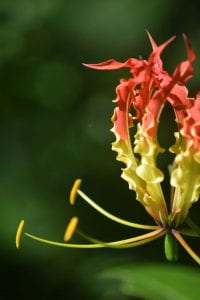
Flower on the first hike

Long exposure photo of stream
After a very chilly night, the first half of the day on Wednesday was spent on a great hike to Kirigalpotta peak (2388m AMSL), Sri Lanka’s second highest mountain. I woke up before this though, and spent nearly an hour outside, watching the sky becoming lighter and the stars disappear – it was long ago since I saw such an amazing sky. I also watched some birds with Mr Lockwood, and we very very lucky to spot a pair of Sri Lankan Bush-Warblers, a rare and range-restricted endemic species of bird. We also found the 4th squirrel species of the trip, the endemic Dusky Squirrel. The 14km hike was challenging, but definitely worth it, as the view at the top was amazing, and on the way we encountered many nice plants and animals. After lunch we searched for some endemic lizards, but we only found Rhino-horned Lizard again, unfortunately not seeing Pygmy Lizard. We finished the day with reflections, and doing long exposure photographs outside, which produced some excellent photos. I never did this type of photography, so it was interesting for me to see how a long exposure can be achieved by a small aperture and low ISO allows the right amount of light onto the sensor.

Sri Lanka Bush Warbler
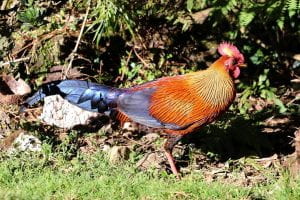
Sri Lanka Junglefowl

Branch in front of the moon on Totupola Kanda

Raspberry branch against morning sun
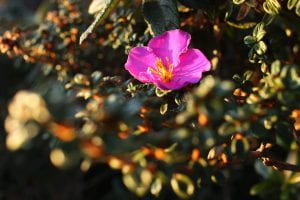
Flower in morning sun
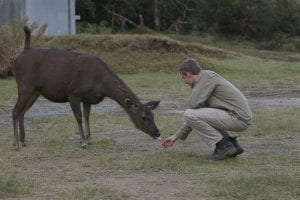
A curious Samba deer. Photo credits: Anuda Weerasinghe
Thursday morning we got up at 5:30, in order to hike to Totupola Kanda, which is the third highest mountain in Sri Lanka at 2357m AMSL. On the top we did some more photography, playing around with shots against the light, which created a high contrast, and a large aperture so that objects a clear even if they are a large distance from each other. After this we packed up and drove to Nuwara Eliya, settling in to the Jetwing hotel – a nice change after two nights in the dorm. Today was one of the most exiting part of the trip for me: an afternoon search for Pied Thrush in the Victoria Park. This bird has a very restricted wintering range, and Victoria Park is one of the few places in the world to realistically see this bird, and even here it can prove challenging to find, as I experienced when I searched for it with my family a year previously (see my birding blog entry here). After one-and-a-half hours of searching, I finally saw a flying female, followed by two males along a stream, where most of us finally caught a glimpse of this sought-after species. After this great find, we did the frog walk from the hotel gardens up into the forest, which turned up all of the 8 species that are known of the area – the usual number is 5 species, according to the guide! It was a great activity as I had never before done any frogging, and it was surprising to see how many animals go unnoticed at night, if you are not actively searching for them!

Black-lipped Lizard
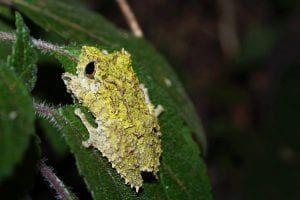
Schmarda’s Shrub Frog

Leaf-nesting Shrub Frog
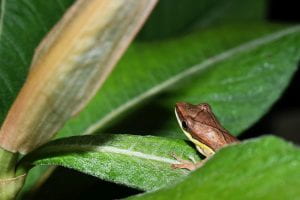
Montane Hourglass Tree Frog
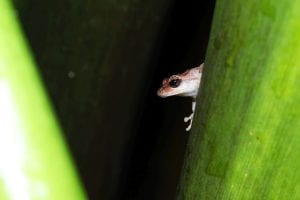
Horton Plains Shrub Frog
The last morning of the trip was the literal highlight as we went up to Sri Lanka’s highest mountain, Piduratalagala, at 2524m AMSL. The view was excellent, and it felt great being on the highest point of Sri Lanka. We also found a new species of lizard, Black-lipped Lizard, of which I took some good photos. After this, we returned to the hotel to pack up our bags, and headed back to Colombo, where we arrived at around 7 PM.
The trip as a whole was a super fun and enriching experience. It was also challenging, particularly the hike to Totupola Kanda, but satisfying and interesting, especially sharing sightings with my classmates. For me, a highlight was the birds, and as I am a very eager birder, it was great adding four new species to my life list, and the trip produced 72 species of birds, 10 species of mammals and many reptiles and amphibians. All the endangered wildlife we saw made me reflect on how sad it is that many unique and beautiful species are becoming rare because of human’s actions, and I felt fortunate to see some of the animals.

Great post Luca, documenting a wonderful trip and learning experience. Thanks for sharing this!
Mr. Lockwood
Great images, Luca!
Wow! This is such a great post! Had so much fun with you during this trip and can’t wait for our geography trip!